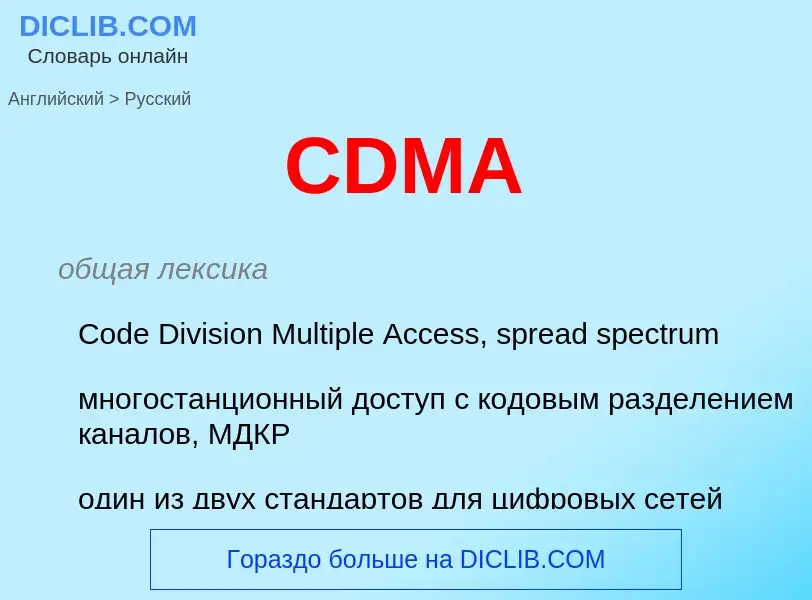Tradução e análise de palavras por inteligência artificial ChatGPT
Nesta página você pode obter uma análise detalhada de uma palavra ou frase, produzida usando a melhor tecnologia de inteligência artificial até o momento:
- como a palavra é usada
- frequência de uso
- é usado com mais frequência na fala oral ou escrita
- opções de tradução de palavras
- exemplos de uso (várias frases com tradução)
- etimologia
CDMA - tradução para Inglês
общая лексика
Code Division Multiple Access, spread spectrum
многостанционный доступ с кодовым разделением каналов, МДКР
один из двух стандартов для цифровых сетей сотовой связи в США. Использует диапазоны частот 800 и 1900 МГц и так называемые шумоподобные сигналы (сигналы с расширенным спектром). Развитием стандарта занимается консорциум CDMA Development Group (CDG, www.cdg.org)
Смотрите также
Definição
Wikipédia
Code-division multiple access (CDMA) is a channel access method used by various radio communication technologies. CDMA is an example of multiple access, where several transmitters can send information simultaneously over a single communication channel. This allows several users to share a band of frequencies (see bandwidth). To permit this without undue interference between the users, CDMA employs spread spectrum technology and a special coding scheme (where each transmitter is assigned a code).
CDMA optimizes the use of available bandwidth as it transmits over the entire frequency range and does not limit the user's frequency range.
It is used as the access method in many mobile phone standards. IS-95, also called "cdmaOne", and its 3G evolution CDMA2000, are often simply referred to as "CDMA", but UMTS, the 3G standard used by GSM carriers, also uses "wideband CDMA", or W-CDMA, as well as TD-CDMA and TD-SCDMA, as its radio technologies.
It can be also used as a channel or medium access technology, like ALOHA for example or as a permanent pilot/signalling channel to allow users to synchronize their local oscillators to a common system frequency, thereby also estimating the channel parameters permanently.
In these schemes, the message is modulated on a longer spreading sequence, consisting of several chips (0es and 1es). Due to their very advantageous auto- and crosscorrelation characteristics, these spreading sequences have also been used for radar applications for many decades, where they are called Barker codes (with a very short sequence length of typically 8 to 32).
For space-based communication applications, CDMA has been used for many decades due to the large path loss and Doppler shift caused by satellite motion. CDMA is often used with binary phase-shift keying (BPSK) in its simplest form, but can be combined with any modulation scheme like (in advanced cases) quadrature amplitude modulation (QAM) or orthogonal frequency-division multiplexing (OFDM), which typically makes it very robust and efficient (and equipping them with accurate ranging capabilities, which is difficult without CDMA). Other schemes use subcarriers based on binary offset carrier modulation (BOC modulation), which is inspired by Manchester codes and enable a larger gap between the virtual center frequency and the subcarriers, which is not the case for OFDM subcarriers. Many carriers (such as AT&T and Verizon) shut down CDMA networks in 2022, rendering CDMA handsets unusable for calls, even to 911.

![A CDMA2000 [[mobile phone]] A CDMA2000 [[mobile phone]]](https://commons.wikimedia.org/wiki/Special:FilePath/Au CDMA 1X WIN W31SAII gravelly silver expansion.jpg?width=200)
